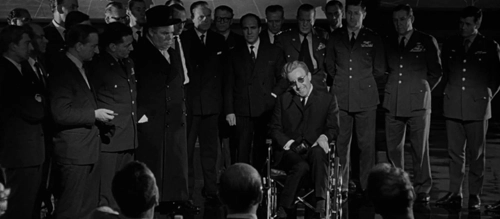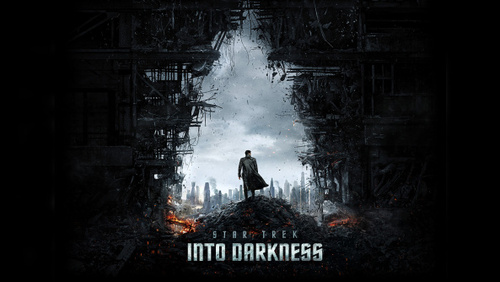
Dr. Strangelove or: How I Learned to Stop Worrying and Love the Bomb (1964)
Director: Stanley Kubrick
Screenwriters: Stanley Kubrick, Terry Southern, Peter George
Starring: Peter Sellers, George C. Scott, Sterling Hayden, Slim Pickens, Peter Bull, Keenan Wynn, James Earl Jones, Tracy Reed, Jack Creley
Originally seeking to adapt Peter George’s “Red Alert” and conceived as a straight thriller under such titles as “The Edge of Doom” and later “The Delicate Balance of Terror” before the screenplay was re-tooled as a dark satire, Stanley Kubrick very nearly didn’t get his way with this, one of his most lasting projects.
Fantasy author Terry Pratchett once wrote about his time working as a publicist for a nuclear plant, where he described how for those in the know there is no funnier phrase than “two completely independent failsafe systems”. The exploitation of human error in a supposedly foolproof system is at the heart of the satirical brilliance of Stanley Kubrick’s Dr. Strangelove or: How I Learned to Stop Worrying and Love the Bomb. An early scene that echoes this irony sees George C. Scott’s stroppy General Turgidson explaining step by step to his president precisely why their multi-layer failsafe systems can’t by overridden, even (especially) when the weak link was human.
At the height of the Cold War, people around the world lived in daily fear of the nuclear obliteration that awaited them perhaps only minutes away. When paranoid US General Jack Ripper (a chilling Sterling Hayden) goes over his authority and orders an immediate nuclear strike on the USSR, it’s up to the unfailingly polite R.A.F. Captain Mandrake (who shares Ripper’s office), the impotent US President Merkin Muffley, and the insane Nazi defector Dr Strangelove – all played by Peter Sellers – to prevent Armageddon.
It says something of the extent to which Dr. Strangelove has ingrained itself in popular culture that when Ronald Reagan was elected president, he was surprised and disappointed to learn that there is not in fact a “War Room” for US military strategising.
Moving at a mile a minute and with no extraneous moments to speak of, this is Stanley Kubrick at his most efficient as a storyteller. He might exaggerate many situations to ridiculous degrees for comic effect, but judging by the outraged response from the US Government and the film studio, he must have hit a nerve by presenting enough uncomfortable truths to the general public. Screenwriter Terry Southern later pondered, “Was it anti-American? Or just anti-military? And the jackpot question: Was it, in fact, anti-American to whatever extent it was anti-military?” and also recalled enraged executive Mo Rothman at Columbia proclaiming that “New York does not see anything funny about the end of the world!”
Absurdist gems are scattered throughout Dr. Strangelove. Bombing wing commander Major Kong’s (Slim Pickens) cowboy hat is kept in the safe next to the military codes; Captain Mandrake doesn’t have enough change to call the President with vital intel to prevent Armageddon, so has to ask the operator to reverse the charges on his call to the White House before resorting to raiding a vending machine; the titular character’s apparently possessed Nazi hand, and; the classic line that comedically defies logic… “Gentlemen, you can’t fight in here. This is the war room!”
After proving his versatility at playing multiple distinct characters in Kubrick’s Lolita two years earlier, Peter Sellers turns in a trio of masterful performances here, after stepping back from playing Major Kong as well due to a combination of a foot injury and not being able to nail the accent. Steve Coogan will be taking on the full quartet of roles in Armando Iannucci’s stage adaptation.

Captain Mandrake might be a character Sellers could have performed in his sleep with the cut glass accent and nervous tics, but the way he plays the tension of having to humour a psychopath is mesmerising. Strangelove as a character is an excuse for Sellers to see just how over-the-top he can go, and President Merkin Muffly is Sellers as his best straight-man, acting with utter incredulity at the escalating situation. His one-sided phone conversations with the (unheard) Soviet Premier “Dmitri” play out like a Bob Newhart routine with the President faltering and becoming increasingly embarrassed at his own country’s sheer incompetence.
Several key members of the ensemble almost steal the show from Sellers (all three of him). Of particular note are Sterling Hayden’s “precious bodily fluids” conspiracy theorist General Ripper who walks that knife-edge of playing madness convincingly, terrifyingly, without turning into a parody of a dangerous and severely mentally ill man. George C. Scott is also great as the posturing blowhard, nuke-first-ask-questions-later General Turgidson. Considering how much of the film takes place at the American airbase on lockdown or in the war room, you’ll rarely not be entertained by Hayden or Scott playing off one of Sellers’ colourful creations.
It is a little problematic that the only visible female character in the whole film is a secretary in a bikini. But if you give it some more thought, of course everyone else in this farce is a man: the concept of M.A.D. (Mutually Assured Destruction) at the dawn of the Nuclear Age couldn’t be any more mad or male an idea if it tried. At least Miss Scott (Tracy Reed) gets a great comic set piece as she takes a call and attempts to relay a complicated code red message to her disinterested lover General Turgidson in the bathroom next door.
This is one of the few films where we hope beyond hope that the classic war movie heroes, the boys on a mission, will not succeed. Many of the classic filmmaking elements are telling us the opposite, from the way every image is captured in striking black-and-white photography that emphasises light and shadow by cinematographer Gilbert Taylor (Star Wars) to the teamwork, camaraderie and improvisation in a tight spot demonstrated by the air crew (including a young James Earl Jones), not to mention the uplifting marching song played throughout their scenes that all run counter to what we know they are trying to achieve. The film language is mocking our expectations of a traditional war film and thereby every real-world jingoistic warmonger.
This is a comedy, but with one of the bleakest endings in film history. Stanley Kubrick clearly thought that we as a species deserved no better. With Paths of Glory (1957) the decade before, he examined how warfare defies reason and turns many previously sane people into fanatics. With Dr. Strangelove he further interrogates the worst aspects of human nature but with far more gallows humour and more terrifying implications in the age of nuclear weapons. Knowing our species as well as Kubrick did, we probably will meet our doom because of someone exploiting a supposedly foolproof system, but at least we might go out laughing as well.
Score: 23/24
Recommended for you: Where to Start with Stanley Kubrick

